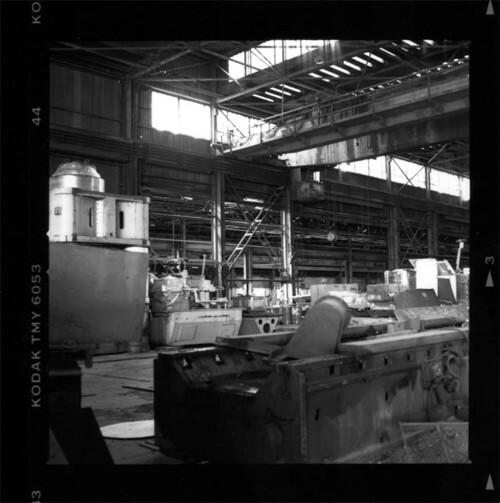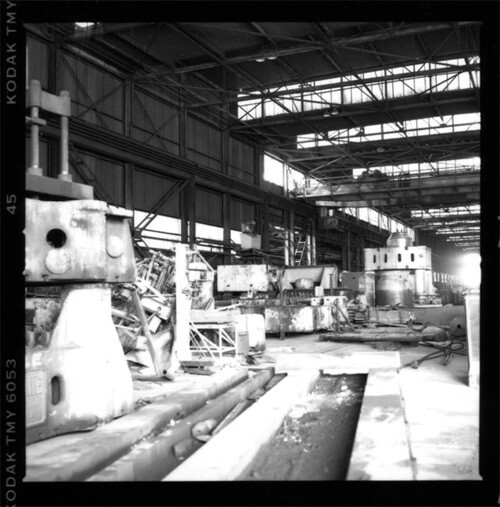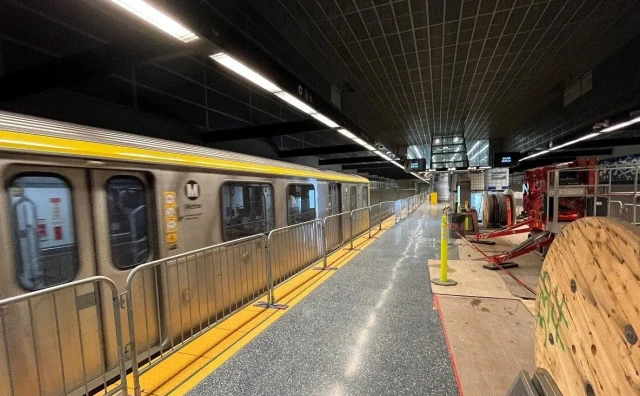With our free press under threat and federal funding for public media gone, your support matters more than ever. Help keep the LAist newsroom strong, become a monthly member or increase your support today during our fall member drive.
This archival content was written, edited, and published prior to LAist's acquisition by its current owner, Southern California Public Radio ("SCPR"). Content, such as language choice and subject matter, in archival articles therefore may not align with SCPR's current editorial standards. To learn more about those standards and why we make this distinction, please click here.
Photo Essay - Kaiser Steel Fontana 1996

Located in the farthest eastern part of Los Angeles county, Fontana is infamous for its distinction as the birthplace of the Hell's Angels and as perhaps the key southern California hub for methamphetamine distribution. Fontana's image to the outside world is now largely the product of its NASCAR speedway, which makes TV appearances throughout the year. Fontana is hot, dry, windy and dirty. The only geological feature of this industrial center in what would otherwise be uninhabitable desert is the presence of massive piles of slag, a byproduct of steel production. These massive mounds of gravel-like material are visible from the 10 freeway, and are an ever present reminder of why Fontana exists in the first place - Kaiser Steel.
All pictures by ©.
The full story and more than 20 images after the jump.

During World War II, Kaiser Steel hastily assembled their Fontana plant, and quickly owned steel production on the west coast, supplying arguably the most crucial material needed at the time to fuel the war effort. The war ended, technology advanced, the Environmental Protection Agency was created, and Kaiser Steel shut down, leaving behind it a sprawling complex of massive warehouses housing machines whose scale dictates that they were clearly designed to make the most amount of material physically possible in the shortest amount of time. When our current governor gets melted into oblivion at the end of Terminator 2, it is in one of the ridiculously huge furnaces at Kaiser. The grandiose interior spaces are staggering in scale, and yet the buildings feel light due to their construction using a steel frame covered with simple corrugated steel panels. Decades of some of the most unforgiving weather conditions available to southern Californians have done their damage to this thin steel skin, allowing majestic beams of sunlight to stream into the buildings, catching the ambient dust and turning the very industrial spaces into something surprisingly beautiful.
Other than speed, dust, and 90 mile per hour winds, the last thing that Fontana is flush with is trucks and everything that one would associate with the sale, operation, or repair of semi tractors and trailers. My father had a truck dealership in Fontana during the 80's and 90's and so I spent a significant amount of time in this most interesting part of the southland.
In the summer of 1996, I went to a rave that just happened to be in Fontana. There was no location posted, but we were directed to park in a huge commercial lot off of the 15 freeway. In one of the sketchiest moments I have ever experienced, we were all loaded in batches of about 30 people into a U-Haul moving van and transported to what I would learn was the Kaiser Steel facility. Stone cold sober, I was blown away by the size of the buildings and machines. I vowed to come back and shoot some photos of the place. The only problem was that I would somehow have to get past security, who had been paid off in order to ignore the event I had just attended.
Among the innumerable colorful characters that I interacted with in Fontana was one of the best repo men in the business, who shall remain unnamed. When I found out his office was a trailer on the Kaiser lot, I hit him up to get me into the place. He could pull that off, but I would still have to avoid security patrols around the buildings. Armed with a Hasselblad, a light meter and a tripod, I managed to dodge security, several work crews, and looming rain clouds to get about 30 minutes of shooting in. Just as the first drops of rain started to fall, I got bounced by a security guy.
Here's what I came up with. These photos have been lost in storage for the last decade, and I am pleased to be able to share them with you today.
I strongly recommend reading the superb and timeless Mike Davis book City of Quartz. The last chapter of this biting and concise look at LA history addresses the quirky nature of Fontana in a very entertaining and informative way that made me want to take a closer look at this seemingly drab industrial town.
Enjoy! ©




















Larger versions of these images can be found here.
At LAist, we believe in journalism without censorship and the right of a free press to speak truth to those in power. Our hard-hitting watchdog reporting on local government, climate, and the ongoing housing and homelessness crisis is trustworthy, independent and freely accessible to everyone thanks to the support of readers like you.
But the game has changed: Congress voted to eliminate funding for public media across the country. Here at LAist that means a loss of $1.7 million in our budget every year. We want to assure you that despite growing threats to free press and free speech, LAist will remain a voice you know and trust. Speaking frankly, the amount of reader support we receive will help determine how strong of a newsroom we are going forward to cover the important news in our community.
We’re asking you to stand up for independent reporting that will not be silenced. With more individuals like you supporting this public service, we can continue to provide essential coverage for Southern Californians that you can’t find anywhere else. Become a monthly member today to help sustain this mission.
Thank you for your generous support and belief in the value of independent news.

-
Kevin Lacy has an obsession with documenting California’s forgotten and decaying places.
-
Restaurants share resources in the food hall in West Adams as Los Angeles reckons with increasing restaurant closures.
-
It will be the second national day of protest against President Donald Trump.
-
The university says the compact, as the Trump administration called it, could undermine free inquiry and academic excellence.
-
This is the one time you can do this legally!
-
Metro officials said it will be able to announce an opening date “soon.”







